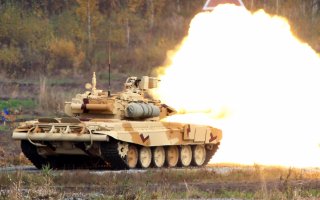What Happened When Russia Sent Its T-90 Tank To Syria?
The tank met its match in the TOW missile.
“In my opinion, the major issue with T-90 (and most other modern tanks) is a complete lack of hard-kill Active Protection System [one that shoots missiles down], ideally with 360 degrees coverage, but 270 degrees should be minimum. This not only means that it is vulnerable to being disabled by cheap rocket propelled grenades in urban combat but also from Anti-Tank Guided Missiles fired from unexpected angle. When you consider the range of current ATGMs [typically two to five miles], it will be fairly regular occurrence that you get a side shot opportunity against attacking enemy tank from positions across from the of attacked location.”
Indeed, Russia is reportedly planning to upgrade its T-90As—which are currently less advanced than the T-90MS’s in service with the Indian Army—to a T-90M variant with new hard-kill active protection systems, upgraded reactive armor, and a more powerful 2A82 main gun. Ultimately, the losses in Syria show that any tank—whether T-90, M-1 or Leopard 2—is vulnerable on a battlefield in which long-range ATGMs have proliferated. Active protection systems and missile warning systems are vital to mitigate that danger—but so are careful tactical employment, competently trained crews, and improved cooperation with infantry to minimize exposure to long-range attacks, ward off ambushers, and provide extra eyes on possible threats.
Sébastien Roblin holds a Master’s Degree in Conflict Resolution from Georgetown University and served as a university instructor for the Peace Corps in China. He has also worked in education, editing, and refugee resettlement in France and the United States. He currently writes on security and military history for War Is Boring.
This article first appeared in 2018.
Image: Reuters

